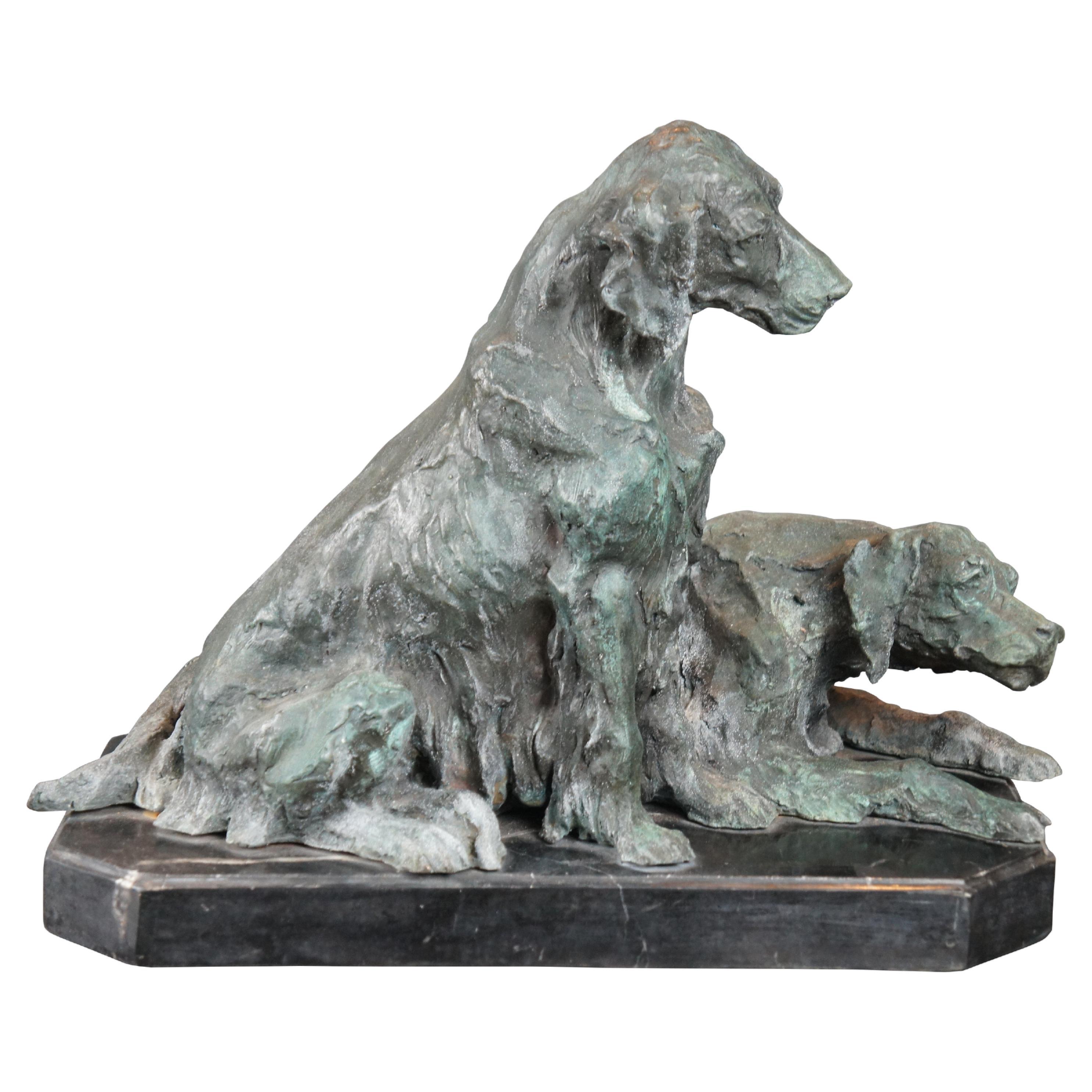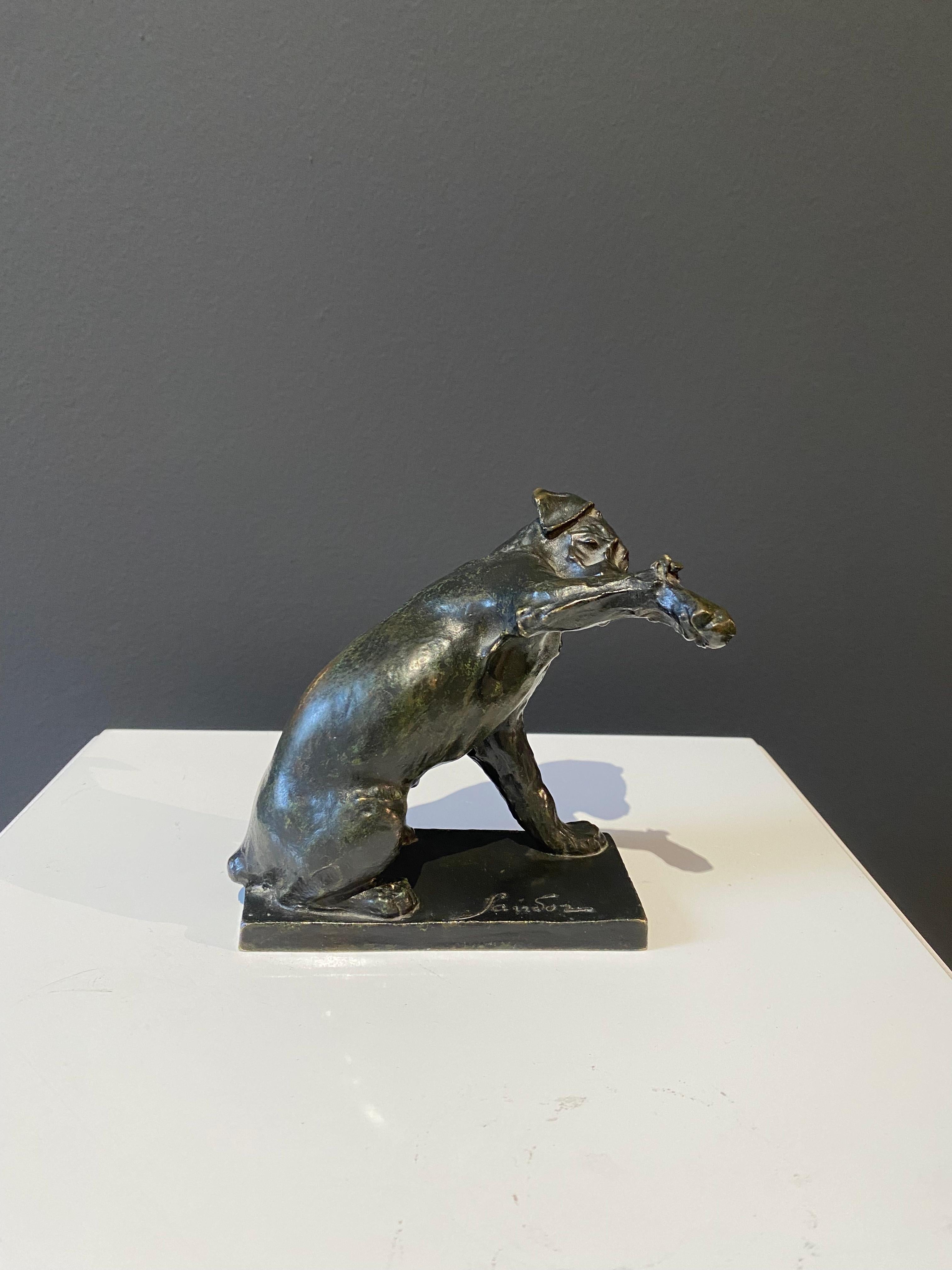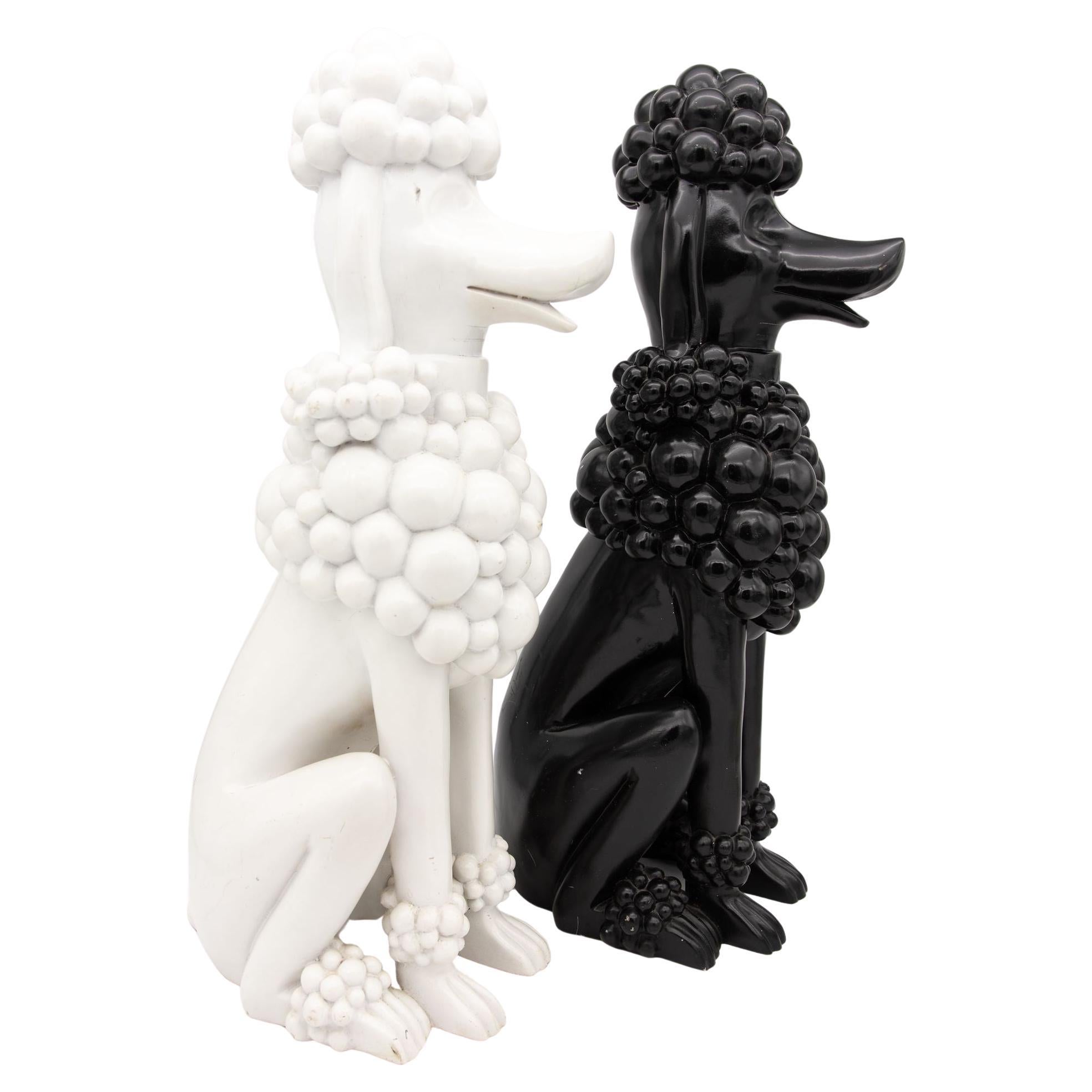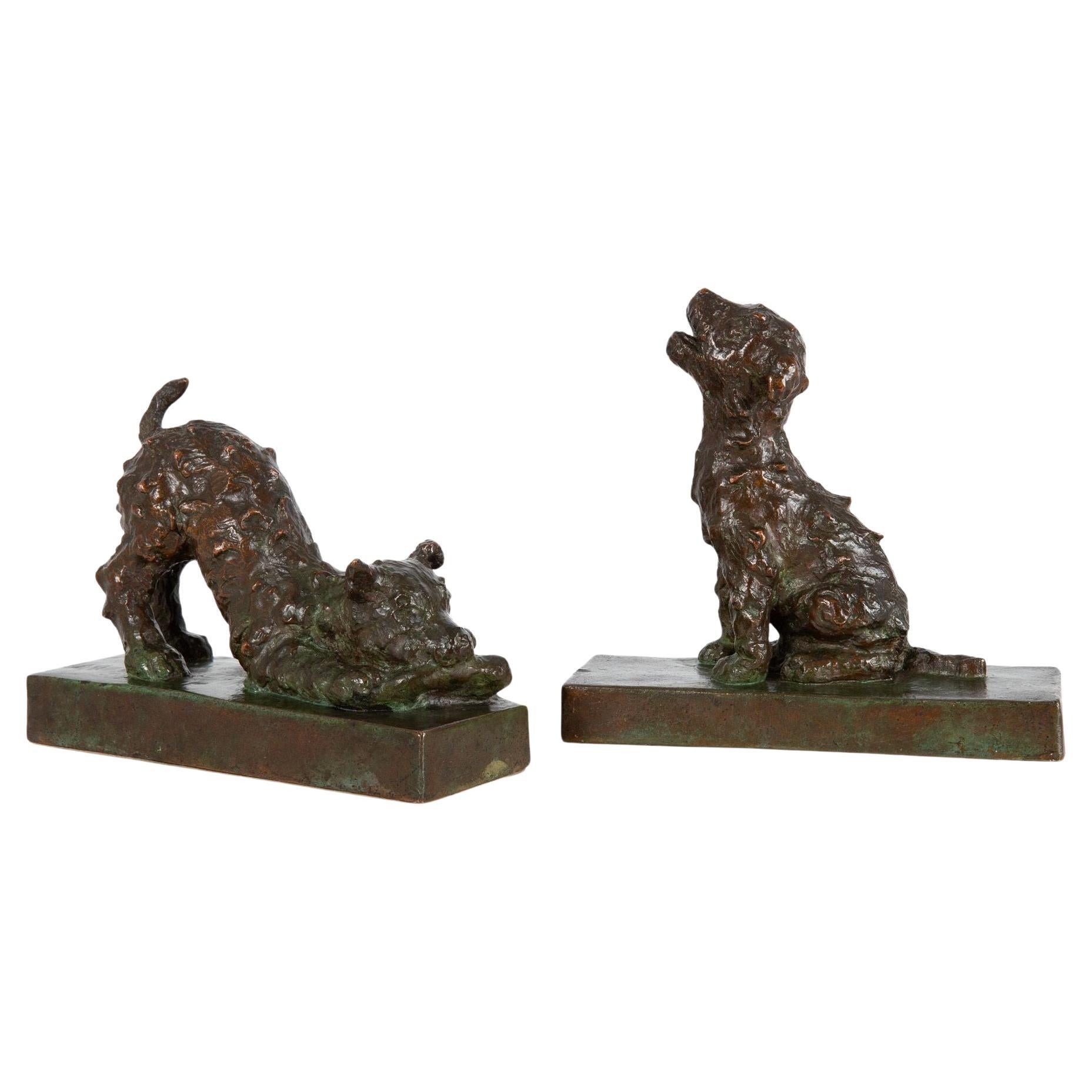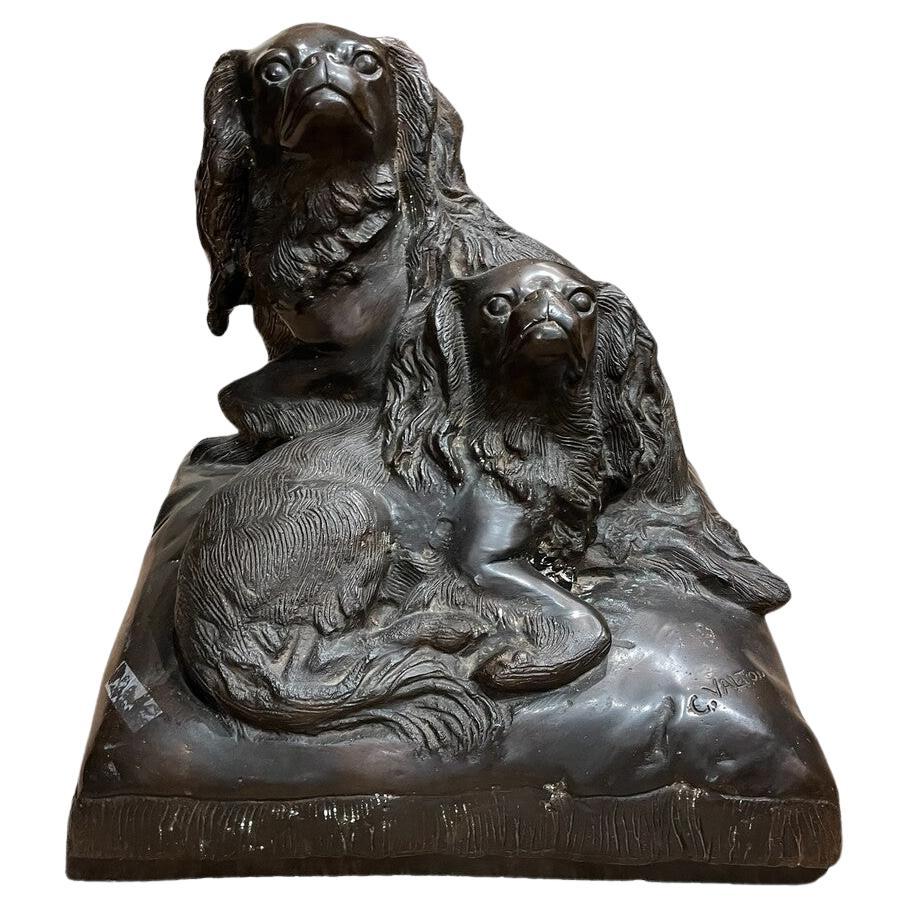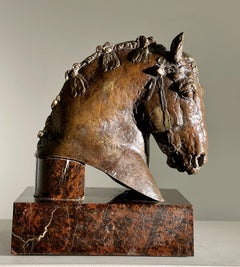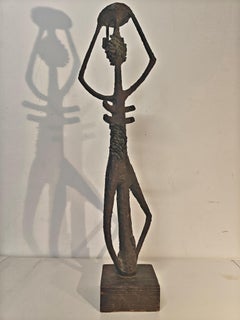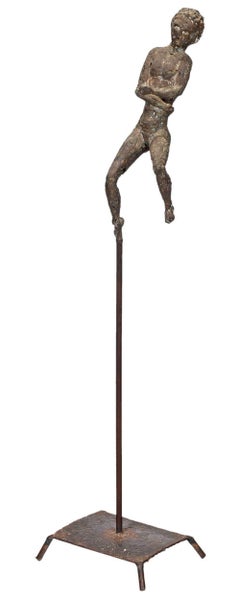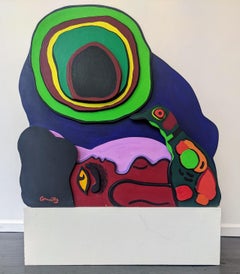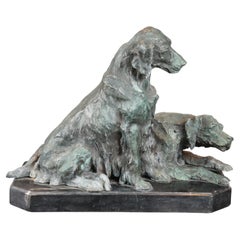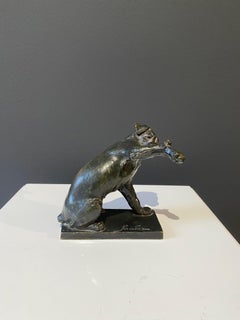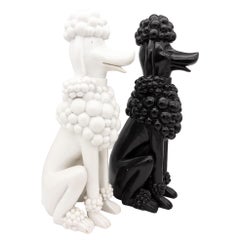Items Similar to "Poodles: Nora and Sheila" Herbert Haseltine, Bronze Dogs Animals Sculpture
Want more images or videos?
Request additional images or videos from the seller
1 of 10
Hebert Haseltine"Poodles: Nora and Sheila" Herbert Haseltine, Bronze Dogs Animals Sculpture1944
1944
$28,000
£21,232.36
€24,566.83
CA$39,579.02
A$44,123
CHF 23,011.96
MX$533,549.35
NOK 289,271.62
SEK 273,708.76
DKK 183,366.28
About the Item
Herbert Haseltine
Poodles: Nora and Sheila, 1944, cast 1945
Signed and dated on base
Bronze with green patina
11 inches high x 17 inches wide x 6 inches deep
Born in Rome, then still Lazio and not part of Italy as such, the son of the wealthy American landscape painter William Stanley Haseltine (1835–1900) who was associated with the Hudson River School and Luminism, he studied at Harvard University. After graduating in 1899, Haseltine went to Munich Academy in Germany to study drawing and then to the Académie Julian in Paris, France where he studied painting.
After his first piece of sculpture met with success, he pursued that artistic avenue. Inspired by the gathering of artists from around the world to the Montparnasse Quarter of Paris, Haseltine chose to make Paris his home for the next thirty-five years until the German occupation of France during World War II. He moved to the United States where he remained until 1947 at which time he returned to France.
Equestrian statue of Sir John Dill statue at Arlington National Cemetery by Haseltine.
In 1940 he was elected into the National Academy of Design as an Associate member and became a full Academician in 1946.
Haseltine sculpted a variety of animals but is best known for his equestrian sculptures, most notably the 1934 life-size statue of the thoroughbred race horse Man o’ War at the Kentucky Horse Park in Lexington, Kentucky and “George Washington on Horseback”, Gilded bronze statue at the Washington National Cathedral made in 1959. He also traveled to India, where he made an oversized statue of one of the ancestors of the Maharaja of Nawanagar, Jam Shri Rawalji in 1933. It can still be seen there. He replicated many of his large works in table-top sizes. The author of a number of books on animalier art, Haseltine was well connected in American upper class society and did a three-year project to create a work for heiress Barbara Hutton. This project included two horses heads which were gilded bronze, with precious and semi precious stones. After her death the heads disappeared and resurfaced a few years ago at an auction in New York.
- Creator:Hebert Haseltine (1877 - 1962, American, Italian, French)
- Creation Year:1944
- Dimensions:Height: 11 in (27.94 cm)Width: 17 in (43.18 cm)Depth: 6 in (15.24 cm)
- Medium:
- Movement & Style:
- Period:
- Condition:
- Gallery Location:New York, NY
- Reference Number:1stDibs: LU1841214835542
About the Seller
5.0
Platinum Seller
Premium sellers with a 4.7+ rating and 24-hour response times
Established in 2022
1stDibs seller since 2022
119 sales on 1stDibs
Typical response time: <1 hour
- ShippingRetrieving quote...Shipping from: New York, NY
- Return Policy
Authenticity Guarantee
In the unlikely event there’s an issue with an item’s authenticity, contact us within 1 year for a full refund. DetailsMoney-Back Guarantee
If your item is not as described, is damaged in transit, or does not arrive, contact us within 7 days for a full refund. Details24-Hour Cancellation
You have a 24-hour grace period in which to reconsider your purchase, with no questions asked.Vetted Professional Sellers
Our world-class sellers must adhere to strict standards for service and quality, maintaining the integrity of our listings.Price-Match Guarantee
If you find that a seller listed the same item for a lower price elsewhere, we’ll match it.Trusted Global Delivery
Our best-in-class carrier network provides specialized shipping options worldwide, including custom delivery.More From This Seller
View All"Sudbourne Premier: Suffolk Punch Stallion" Herbert Haseltine, 1927 Bronze
Located in New York, NY
Herbert Haseltine
Sudbourne Premier: Suffolk Punch Stallion, 1927
Signed left side: © HASELTINE / MCMXXVII
Bronze, dark brown patina, parcel gilding
...
Category
1920s Realist Figurative Sculptures
Materials
Bronze
"Untitled" David Hare, Surrealist, Anthropomorphic, Modernist, Ab-Ex Sculpture
By David Hare
Located in New York, NY
David Hare
Untitled, circa 1949
Bronze
25 x 8 x 7 inches
Provenance
Kootz Gallery, New York
Collection of Samuel Kootz New York
Estate of the above
Collection of Dr. Joyce Kootz, Ne...
Category
1940s Surrealist Abstract Sculptures
Materials
Bronze
"Dancer" David Hare, Male Nude, Figurative Sculpture, Mid-Century Surrealist
By David Hare
Located in New York, NY
David Hare
Dancer, circa 1955
Bronze with integral stand
68 high x 17 wide x 13 1/2 deep inches
“Freedom is what we want,” David Hare boldly stated in 1965, but then he added the caveat, “and what we are most afraid of.” No one could accuse David Hare of possessing such fear. Blithely unconcerned with the critics’ judgments, Hare flitted through most of the major art developments of the mid-twentieth century in the United States. He changed mediums several times; just when his fame as a sculptor had reached its apogee about 1960, he switched over to painting. Yet he remained attached to surrealism long after it had fallen out of official favor. “I can’t change what I do in order to fit what would make me popular,” he said. “Not because of moral reasons, but just because I can’t do it; I’m not interested in it.”
Hare was born in New York City in 1917; his family was both wealthy and familiar with the world of modern art. Meredith (1870-1932), his father, was a prominent corporate attorney. His mother, Elizabeth Sage Goodwin (1878-1948) was an art collector, a financial backer of the 1913 Armory Show, and a friend of artists such as Constantin Brancusi, Walt Kuhn, and Marcel Duchamp.
In the 1920s, the entire family moved to Santa Fe, New Mexico and later to Colorado Springs, in the hope that the change in altitude and climate would help to heal Meredith’s tuberculosis. In Colorado Springs, Elizabeth founded the Fountain Valley School where David attended high school after his father died in 1932. In the western United States, Hare developed a fascination for kachina dolls and other aspects of Native American culture that would become a recurring source of inspiration in his career.
After high school, Hare briefly attended Bard College (1936-37) in Annandale-on-Hudson. At a loss as to what to do next, he parlayed his mother’s contacts into opening a commercial photography studio and began dabbling in color photography, still a rarity at the time [Kodachrome was introduced in 1935]. At age 22, Hare had his first solo exhibition at Walker Gallery in New York City; his 30 color photographs included one of President Franklin Roosevelt.
As a photographer, Hare experimented with an automatist technique called “heatage” (or “melted negatives”) in which he heated the negative in order to distort the image. Hare described them as “antagonisms of matter.” The final products were usually abstractions tending towards surrealism and similar to processes used by Man Ray, Raoul Ubac, and Wolfgang Paalen.
In 1940, Hare moved to Roxbury, CT, where he fraternized with neighboring artists such as Alexander Calder and Arshile Gorky, as well as Yves Tanguy who was married to Hare’s cousin Kay Sage, and the art dealer Julian Levy. The same year, Hare received a commission from the American Museum of Natural History to document the Pueblo Indians. He traveled to Santa Fe and, for several months, he took portrait photographs of members of the Hopi, Navajo, and Zuni tribes that were published in book form in 1941.
World War II turned Hare’s life upside down. He became a conduit in the exchange of artistic and intellectual ideas between U.S. artists and the surrealist émigrés fleeing Europe. In 1942, Hare befriended Andre Breton, the principal theorist of surrealism. When Breton wanted to publish a magazine to promote the movement in the United States, he could not serve as an editor because he was a foreign national. Instead, Breton selected Hare to edit the journal, entitled VVV [shorth for “Victory, Victory, Victory”], which ran for four issues (the second and third issues were printed as a single volume) from June 1942 to February 1944. Each edition of VVV focused on “poetry, plastic arts, anthropology, sociology, (and) psychology,” and was extensively illustrated by surrealist artists including Giorgio de Chirico, Roberto Matta, and Yves Tanguy; Max Ernst and Marcel Duchamp served as editorial advisors.
At the suggestion of Jacqueline Lamba...
Category
1950s Abstract Figurative Sculptures
Materials
Bronze
$20,000 Sale Price
20% Off
"Tropical Parrot with Woman, " Corneille, Carved Wood Sculpture with Bird
By Corneille
Located in New York, NY
Guillaume Cornelis van Beverloo (Corneille)
Tropical Parrot with Woman, circa 1970
Signed: Corneille
Edition Number: 6 of 8
Constructed and Painted wood
39" high x 40 1/2" wide x 6" ...
Category
1970s Figurative Sculptures
Materials
Wood, Paint
"Young Woman Nude" Warren Wheelock, Art Deco, Modernist Female Sculpture Form
By Warren Wheelock
Located in New York, NY
Warren Wheelock
Untitled (Young Woman Nude), 1924
Incised signature and date to edge of base "© 1924 by Warren Wheelock"
Bronze
Sculpture: 20 h × 4½ w...
Category
1920s Art Deco Figurative Sculptures
Materials
Bronze
"Faun and Fawn" Aaron Bohrod, Realist Still Life, Deer and Putti
By Aaron Bohrod
Located in New York, NY
Aaron Bohrod
Faun and Fawn, 1984
Signed lower right
Oil on gesso board
16 x 12 inches
Aaron Bohrod's work has not been limited to one style or medium. Initially recognized as a regionalist painter of American scenes, particularly of his native Chicago, Bohrod later devoted himself to detailed still-life paintings rendered in the trompe l'oeil style. He also worked for several years in ceramics and wrote a book on pottery.
Born in 1907, Bohrod began his studies at Chicago's Crane Junior College in 1925, and two years later enrolled in the Art Institute of Chicago. But it was at the Art Students League in New York City, from 1930 to 1932, that he studied under the man believed to be his most significant early influence, John Sloan. Sloan's romantic realism is reflected in the many depictions of Chicago life, which comprised most of Bohrod's early work.
Under Sloan's tutelage, Bohrod came to subscribe to the belief that painters should find the subjects of their art in the immediate world around them. These paintings emphasized architecture unique to north Chicago and featured Chicagoans engaged in such everyday activities as working, playing or going to the theatre. The romantic aspect was conveyed by the use of misty colors, and the realism by attention to detail.
In 1936, Bohrod won the Guggenheim Fellowship award in creative painting...
Category
1980s Realist Animal Paintings
Materials
Oil, Board
You May Also Like
Vtg Bronze Sculpture of 2 Labrador Retrievers After Pierre Jules Mene Statue 18"
By Pierre Jules Mêne
Located in Dayton, OH
Late 20th Century bronze sculpture featuring two retrievers hunting dogs, one resting and the other kneeling. The bronze is done in French manner After Pierre Jules Mene Statue...
Category
Late 20th Century Animal Sculptures
Materials
Marble, Bronze
$468 Sale Price
20% Off
Edith Parsons Pair of Terrier Pups - Bookends Bronze Sculptures
By Edith Barretto Stevens Parsons
Located in Phoenix, AZ
Edith Baretto Parsons (1878-1956) pair of lost-wax cast patinated bronze dog sculptures.
The seated pup is signed in the cast “E.B. Parsons” and cold stamped Gorham Co. OFFW.
It measures 5 3/4"high x 6 7/8"long x 2 1/2"wide.
The leaping pup is signed in the cast “E.B. Parsons,” dated 1911 and cold stamped B. Zoppo
Foundry, N.Y. It measures 6 1/2"high x 6 3/4"long x 2 ½"wide.
These are part of Parsons' series of playful terrier dogs and are highly desirable.
They are in excellent condition with no damage.
Born in Virginia, Edith Parsons studied at the Art Students League in New York with John Twachtman, Daniel Chester French...
Category
1910s Figurative Sculptures
Materials
Bronze
Chien à la sauterelle, Sandoz, Dog, Sculpture, Bronze, Animal, 1910's
By Edouard-Marcel Sandoz
Located in Geneva, CH
Chien à la sauterelle, Sandoz, Dog, Sculpture, Bronze, Animal, 1910's
Chien à la sauterelle
Susse Fondeur
circa 1918-1930
Bronze with brown patina and shade of green
13 x 13 x 9 cm
Signed and seal of the foundry on the base : Sandoz, Susse Fondeur
Catalogue raisonné de l'oeuvre sculpté de Edouard Marcel Sandoz, sculpteur figuriste et animalier 1881-1971, by Félix Marcilhac, Les Editions de l'amateur, 1993...
Category
1910s Modern Figurative Sculptures
Materials
Bronze
Pair Composite Poodles, Late 20th Century
Located in South Salem, NY
A delightful duo of composite lifesize Poodles, one ebony and one snowy white! Likely advertising models, these enchanting sculptures radiate charm and joy with their endearing and c...
Category
Late 20th Century French Animal Sculptures
Materials
Composition
$2,400 / set
Rare Pair of “Terriers” Bookends Bronze Sculpture by Edith Baretto Parsons
By Edith Barretto Stevens Parsons
Located in Shippensburg, PA
Part of Parsons' series of playful terrier dogs, this is a highly desirable original pair that have remained together since being issued by the Gorham foundry...
Category
20th Century American Art Deco Animal Sculptures
Materials
Bronze
19th C Bronze Cavalier King Charles Spaniels by C. Valton
By Charles Valton
Located in Houston, TX
Immerse yourself in the charm of this exquisite bronze sculpture by renowned French artist Charles Valton (1851-1918). Crafted with precision using the lost wax casting technique, it...
Category
Antique 19th Century French Other Animal Sculptures
Materials
Bronze
More Ways To Browse
Large Table Sculptures
Green Patina Sculptures
Green Patina Bronze Sculpture
Bronze Table Top Sculpture
Animalier Sculpture Bronze
French Animalier Sculpture
Bronze Sculpture India
Bronze Patina Horse Sculpture
Bronze Statue Of Man
Green Horse Sculpture
Large Bronze Horse Sculpture
1900 Bronze Statue
Lexington Vintage
Green River Stone
Bronze Horse Head
Green Bronze Statue
Gold Horse Statue
Bronze Horse Table
